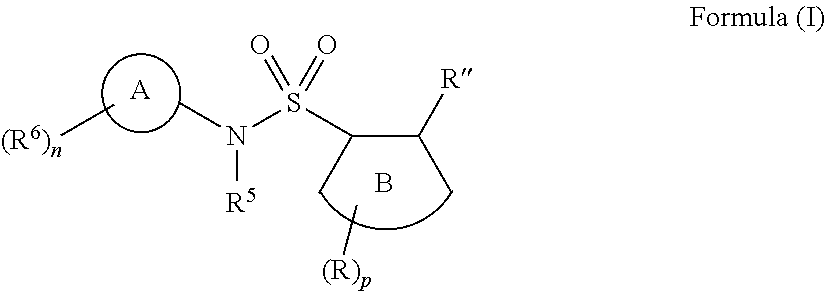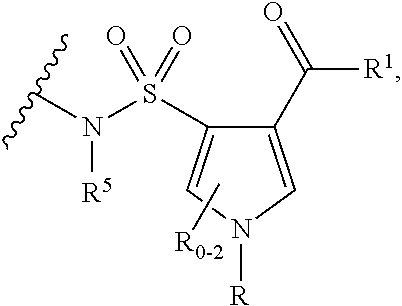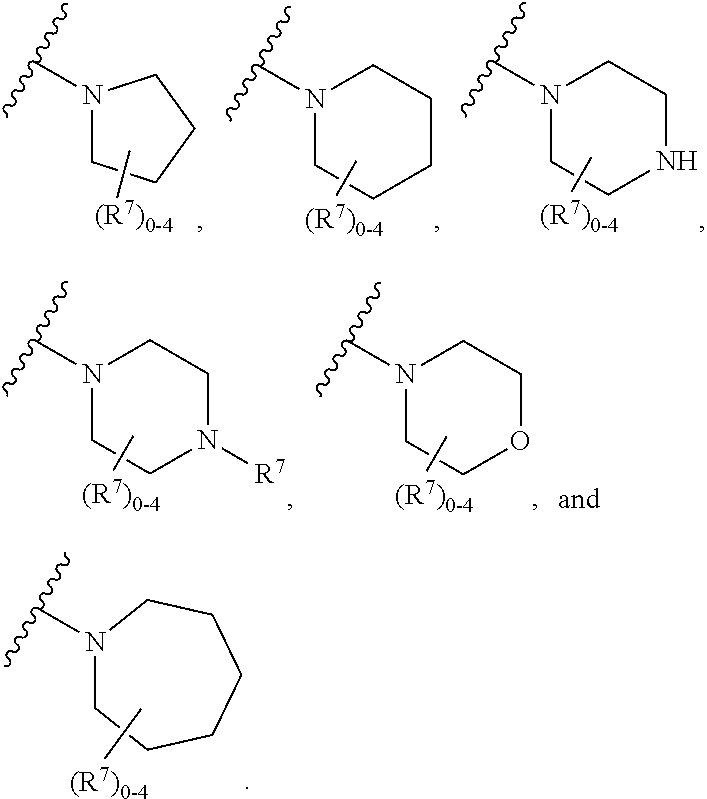Compounds, compositions and methods of use
a technology of compositions and compounds, applied in the field of compound compositions and methods of use, can solve the problems of difficulty in disaggregating, unfavorable use, and impaired function, and achieve the effect of improving the stability and stability of the compound, and avoiding the formation of asymmetric aggregation
- Summary
- Abstract
- Description
- Claims
- Application Information
AI Technical Summary
Benefits of technology
Problems solved by technology
Method used
Image
Examples
example 1
of N-(2-ethyl-6-methylphenyl)-2-(pyrrolidine-1-carbonyl)-benzenesulfonamide (Compound 100)
[0322]
Step 1: Methyl 2-(N-(2-ethyl-6-methylphenyl)sulfamoyl)benzoate (A2)
[0323]
[0324]To a solution of A1 (300 mg, 1.28 mmol) and 2-ethyl-6-methyl-aniline (173 mg, 1.28 mmol) in DCM (5.00 mL) was added pyridine (202 mg, 2.56 mmol). The mixture was stirred at 40° C. for 16 hrs, after which TLC analysis (petroleum ether:ethyl acetate=5:1, Rf=0.29) indicated the reaction was complete. The reaction mixture was concentrated under reduced pressure to remove solvent to afford A2 (300 mg, crude) as a red oil, which was directly used without further purification.
Step 2: N-(2-ethyl-6-methylphenyl)-2-(pyrrolidine-1-carbonyl)-benzenesulfonamide (Compound 100)
[0325]
[0326]A mixture of A2 (300 mg, 900 umol) and pyrrolidine (1.02 g, 14.3 mmol) was stirred at 60° C. for 3 hrs, after which TLC analysis (petroleum ether:ethyl acetate=5:1, Rf=0.15) indicated A2 was consumed completely. The reaction mixture was conc...
example 2
of N-(2-ethyl-6-methylphenyl)-4-(pyrrolidine-1-carbonyl)pyridine-3-sulfonamide (Compound 101)
[0327]
Step 1: Pyridine-3-sulfonyl chloride (A4)
[0328]
[0329]To a mixture of A3 (9.00 g, 56.6 mmol) in SOCl2 (108.00 mL) was added DMF (5.00 mL) in one portion at 25° C. under N2. The mixture heated to 80° C. and stirred for 12 hours, after which LCMS analysis indicated the reaction was complete. The reaction mixture was concentrated under reduced pressure to give A4 (9.00 g, yield: 89.6%), which was used in the next step without further purification. 1H NMR (400 MHz, CDCl3) δ:8.98 (s, 1H), 8.91 (d, J=5.6 Hz, 1H), 8.72 (d, J=8.0 Hz, 1H), 8.07-8.10 (m, 1H).
Step 2: N-(2-ethyl-6-methylphenyl)pyridine-3-sulfonamide (Compound 102)
[0330]
[0331]To a solution of 2-ethyl-6-methylaniline (4.57 g, 33.9 mmol) in CH2Cl2 (100 mL) and pyridine (20.0 mL) was added a solution of A4 (5.00 g, 28.2 mmol) in CH2Cl2 (50.00 mL) and pyridine (30.0 mL) dropwise at 0° C. under N2. The mixture was stirred at 25° C. for 2...
example 3
onse Assay for TDP-43 Inhibition
[0336]Exemplary compounds of the invention were evaluated for efficacy in inhibiting TDP-43 inclusions using a dose response assay. Briefly, PC12 cells stably expressing wild type (WT) TDP-43-GFP were stressed with 15 μM to induce TDP-43 inclusions. The cells were then treated with exemplary compounds of the invention and the inhibitory effect on TDP-43 inclusions was observed using fluorescent microscopy. The ratio of cells with TDP-43 inclusions was calculated based on the total number of cells with detectable GFP expression. A 12-point dose response curve was generated, and the IC50 for each compound tested was determined. Results of the dose response assay for exemplary compounds of the invention are summarized in Table 1, wherein A represents an IC50 value of 50 value of 101-250 nM; C represents an IC50 value of 251-500 nM; D represents an IC50 value of >500 nM; and ND signifies that the IC50 value was not determined.
PUM
| Property | Measurement | Unit |
|---|---|---|
| Pharmaceutically acceptable | aaaaa | aaaaa |
Abstract
Description
Claims
Application Information
 Login to View More
Login to View More - R&D
- Intellectual Property
- Life Sciences
- Materials
- Tech Scout
- Unparalleled Data Quality
- Higher Quality Content
- 60% Fewer Hallucinations
Browse by: Latest US Patents, China's latest patents, Technical Efficacy Thesaurus, Application Domain, Technology Topic, Popular Technical Reports.
© 2025 PatSnap. All rights reserved.Legal|Privacy policy|Modern Slavery Act Transparency Statement|Sitemap|About US| Contact US: help@patsnap.com



